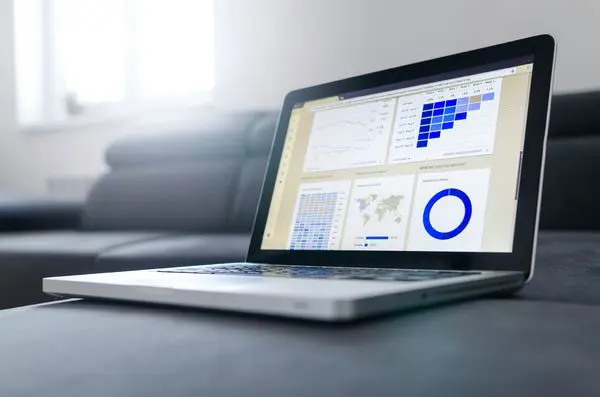Blog
Take Digital Marketing to the Next Level with Data Visualisation Techniques
06 June 2019
In the realm of digital marketing, you have a few seconds to grab someone’s attention. Storytelling is the best way to do that. Research shows that when humans are exposed to stories, the brain actually releases a cocktail of chemicals that makes us feel better. One of the best ways to tell a story in digital marketing is through data visualisation.

What are the best ways to utilise data visualisation in digital marketing?Which data visualisation techniques allow your marketing to be more effective and successful?
Where Do Data Visualisation Techniques Fit into Storytelling?
Before examining where data visualisation techniques fit into storytelling (and into digital marketing as a whole), it makes sense to explore effective ways to share information.
Suppose someone presents information in two ways: in a chart, just containing numbers and words, and in a bar graph. Which would the viewer find more appealing? If you said the bar chart, you’d be correct. That answer is based on human physiology.
Almost half of the human brain is involved in visual processing.
The human brain is hardwired to process visual information. Almost half of the human brain is involved in visual processing. Humans recall 80 percent of what they see and do, making visually-transmitted information incredibly powerful.
So, it makes sense that conveying information through images is an effective way of communicating. That’s where data visualisations come into the picture. They provide meaning and value to information.
What Do You Need to Know about Data Visualisation Techniques?
Since data visualisation is so valuable, digital marketers are wise to explore various data visualisation techniques. Data visualisation techniques matter, because if you choose the wrong one, your marketing won’t be as effective as it could be.
The first crucial thing to keep in mind is which data to use. There is so much information available today; quite frankly, it’s overwhelming. Moreover, statistics in and of themselves are confusing, and if you don’t choose the information that supports your message, you won’t get through to customers.
The first data visualisation technique is choosing the right data.
Along those lines, select credible data for your visualisations. You don’t want to use information from a source that no one trusts. If people find out that your data is inaccurate, it will ruin your reputation, as well as cost you customers.
Secondly, keep in mind what kinds of information would interest your audience. If your audience is businesspeople who want to understand the effect of regulatory fines on your business, tailor your data visualisations accordingly. If a visualisation isn’t relevant to your audience, they’ll ignore it, which ends up costing you money.
Choose the right type of visualisation for your marketing efforts.
Take some time to consider what the right type of visualisation is for your marketing efforts. You should keep in mind what kind of visualisation you need for the information, the audience, and your goal. For example, if you want to illustrate a change over a time period that features a number of data points, you might illustrate this data effectively with a line graph.
Third, remember that colour theory is your friend. When you select the right colour scheme for your data visualisation, it will come to life; colours can attract or repel the eye. Furthermore, keep your colour scheme consistent throughout your data visualisations. Clearly contrasting colours (such as red for downward trends and green for good news) will help you drive home your point.
Keep your data visualisations clean and sleek.
A fourth data visualisation technique to remember is to keep your visualisations clean and sleek. Don’t let them fall prey to clutter. Your goal isn’t to confuse or even repel your audience (which is what cluttered designs do). You want to educate and ultimately convince them that yours is the right solution for their needs.

Put Your Data Visualisation Techniques into Practise with Microsoft Power BI
Microsoft Power BI is a business analytics service that delivers insights throughout the enterprise. One of the functionalities it possesses is the ability to create stunning data visualisations.
One of the benefits of Microsoft Power BI is that it allows you to connect to hundreds of data sources. As mentioned earlier, there’s more information out there than ever before. With Power BI, you can harness the power of that data for illustrative, compelling visualisations.
You can harness the power of data for illustrative, compelling visualisations.
Because those data sources come from systems of record, you don’t have to worry that they’re not accurate or up-to-date. As a result, audiences can trust your data visualisations.
Another advantage of Microsoft Power BI is that you can easily share your data with others, and they can access the visualisations on any device. In this day and age, that’s a crucial capability. You don’t want a potential customer to become frustrated because he or she can’t view your visualisation.
You can access Microsoft Power BI data visualisations on any device.
Additionally, Power BI incorporates Power Query, a technology that enables you to combine, transform, and organise massive amounts of data. You no longer need to invest in costly data analysts to perform all of those functions.
To create visualisations in Microsoft Power BI, you have a few options at your disposal. AI-assisted visualisations are created automatically for your data set. You can use the custom visuals open framework, or you can choose from over 100 visuals published by the community of Microsoft Power BI users.
Power Query enables you to combine, transform, and organise massive amounts of data.
What if you don’t know which data visualisation to choose? Type a question into Microsoft Power BI, and it will help you select the right visualisation for your goals.
Choose Enlighten to Help Implement the Right Data Visualisation Techniques
Enlighten Designs has over 20 years of experience in helping companies transform raw data into compelling, attractive and meaningful data visualisations. We’re a proud Microsoft partner, and we can assist you in utilising Microsoft Power BI to its fullest. To learn more, contact us.
Recent Articles
- Look what happens when the creator of the Enlighten Aquarium gets a 3d printer!
- Performance of PHP Web Applications migrated to Azure PaaS
- Azure Static Web Apps - Performance
- Legacy Application Decomposition Patterns: A Key to Successful Application Modernisation
- Google's Gemini 1.0 - A Formidable New Player in AI
Want to stay updated with what we are doing?
Subscribe to our newsletter for our ideas about development, marketing, and technology. See our latest work, find out about career opportunities, and stay notified about upcoming events.
Subscribe to our newsletter


